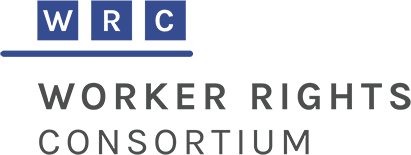Viewing all content with location: Ethiopia
Use the form to filter results
Search by Keyword
Type
Date Range
Issue
Everest Apparel
Published: September 6, 2024
The WRC documented several serious labor rights violations at Everest Apparel, a factory located in Ethiopia. These included: unlawful wage deductions, failure to provide a weekly rest day, mandatory overtime, verbal abuse, restrictions on paid statutory leave, suppression of workers’ right to freedom of association, and unsafe factory temperatures. The WRC shared our findings and…
Country Update and Two Collegiate Case Updates
Published: September 6, 2024
September 6, 2024 Dear Colleagues, As the school year kicks off, I am writing to provide updates on several items we reported on over the summer. At Style Avenue, the collegiate factory in El Salvador that closed without paying workers $1.8 million in legally mandated compensation, we completed the distribution of $1.2 million to workers, using…
Back Pay and Remediation of Labor Rights Violations at a Collegiate Supplier in Ethiopia
Published: July 31, 2024
To: WRC Affiliate Universities and Colleges From: Rola Abimourched and Scott Nova Date: July 31, 2024 Re: Back Pay and Remediation of Labor Rights Violations at a Collegiate Supplier in Ethiopia Please find here a new report on the WRC’s findings, recommendations, and full remediation of labor rights violations at Everest Apparel (“Everest”), a factory…
Code Compliance Successes in Ethiopia, Bangladesh, India, and Cambodia
Published: December 16, 2022
To: WRC Affiliate Universities and Colleges From: Jessica Champagne and Scott Nova Date: December 16, 2022 Re: Code Compliance Successes in Ethiopia, Bangladesh, India, and Cambodia As we near the end of 2022, we write to provide brief updates on four cases that were resolved this year. In each case, the WRC documented violations of…
KGG Garments, Plc
Published: December 16, 2022
In March 2022, the WRC secured a commitment from the university licensee, Cutter & Buck, to provide the equivalent of more than four months’ wages to over 1,300 workers, to remedy violations of law at a factory in Ethiopia producing university logo apparel. The breaches of law—nonpayment of legally mandated severance and terminal benefits—were committed…
Brands Guilty of ‘Straight-Out Robbery’ as Covid-Hit Garment Workers Risk ‘Unbearable’ Debt: Report
Published: June 23, 2021
Industry response to pandemic fuels forced labour risk
Published: June 22, 2021
Industrie du vêtement La détresse des travailleurs exacerbée par la pandémie
Published: June 22, 2021
Pandemic Has Increased Risk of Forced Labour in Garment Industry, Study Finds
Published: June 21, 2021
The Unequal Impacts of Covid-19 on Global Garment Supply Chains
Published: June 21, 2021
This report documents deteriorating living and working conditions for workers in garment supply chains, including a surge in vulnerability to forced labour, amidst the Covid-19 pandemic.
We find that garment workers’ labour and living conditions have severely worsened during the pandemic and workers are experiencing severe economic hardship and labour abuse. Across all four of our case study countries, workers have experienced sharp declines in earnings and working conditions, including increased vulnerability to key indicators of forced labour. These dynamics are evident for workers who have remained in the same jobs with no change in their employment status, as well for those who have had their contracts terminated amidst the pandemic and found new jobs; which have often involved worse working conditions and lower pay compared to their pre-pandemic employment. These patterns varied across case study country; individual level factors such as age, gender, race and ethnicity, union affiliation, migration and employment status; and commercial dynamics in supply chains.
